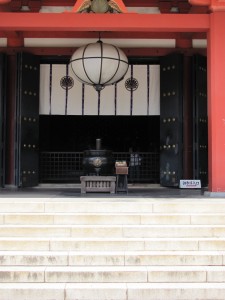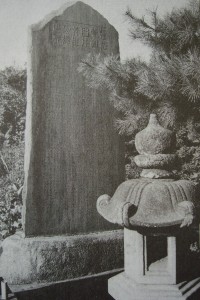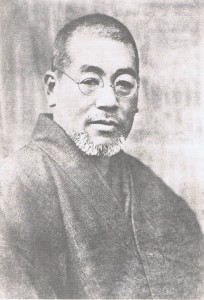Mikao Usui – the Founder of Reiki
Mikao Usui – the founder of Usui Reiki Ryoho
Mikao Usui was a modest man who lived in Japan at a time when there were many different streams of thought and cultural influence, both Eastern and Western. He devoted his life to finding the purpose of life and, after deep meditation on Mount Kurama, was gifted with the experience of Reiki. The creation of the Reiki practice to which he gave his name developed as he gained understanding of the gift he had been given.
Kurama-yama, or Mount Kurama, is a short train ride from Kyoto. It is considered to be a place of particular spirituality, and has a beautiful temple that is still in use. Many people from around the world visit Mount Kurama as a spiritual pilgrimage. Many people who have the blessing of Reiki in their lives visit Kurama-yama to honour the founder and original teacher of Reiki, Mikao Usui.

Entrance to the Temple on Kurama yama
After his enlightenment experience on Mount Kurama, Mikao Usui devoted his life to healing, and to teaching Usui Reiki Ryoho. He founded the Usui Reiki Ryoho Gakkai, which was his teaching school, an association which still exists in Japan to this day. In the West, we normally refer to Usui Reiki Ryoho simply as Reiki.
Mikao Usui is buried at a temple in Tokyo. After his death, the Usui Reiki Ryoho Gakkai commissioned a memorial stone to be erected, which honoured the life of their founder and teacher (sensei).

Mikao Usui’s memorial stone
There are a number of different translations in existence of Mikao Usui’s memorial stone, here is one of them:
Memorial of the merits of Usui Sensei, the founder of Reiki Ryoho
at Saihoji Temple in Toyotama-gun, JapanThat which is attained within oneself after having accumulated the fruits of disciplined study and training is called ‘Toku’ and that which can be offered to others after having spread a path of teaching and salvation is called ‘Koh’. Only with high merits and great virtues can one be a great founding teacher. Sagacious and brilliant men of the olden time or the founders of new teachings and religious sects were all like that. Someone like Usui Sensei can be counted among them. Sensei newly founded the method based on Reiki of the universe to improve the mind and body. Having heard of his reputation all over, people crowded around to seek his teachings and treatments. Ah, how popular it is!
Sensei, commonly known by the name Mikao, with an extra name Gyohan is from Taniai-mura (village) Yamagata-gun (county), Gifu-ken (prefecture). He is descended from Chiba Tsunetane. His father’s name was Taneuji, and was commonly called Uzaemon. His mother was from the Kawai family.
Sensei was born on August 15 of the first year of Keio (1865 AD). From his youth he surpassed his fellows in hard work and endeavour. When he grew up he visited Europe and America, and studied in China. Despite his will to succeed in life, he was stalemated and fell into great difficulties. However, in the face of adversity he strove to train himself even more with the courage never to yield.
One day, Mikao Usui climbed Kurama-yama and after 21 days of a severe discipline without eating, he suddenly felt One Great Reiki over his head and attained enlightenment and he obtained Reiki Ryoho. Then, he tried it on himself and experimented on his family members. The efficacy was immediate. Sensei thought that it would be far better to offer it widely to the general public and share its benefits than just to improve the wellbeing of his own family members. In April of the 11th year of Taisho (1922 AD) he settled in Harajuku, Aoyama, Tokyo and set up the Gakkai to teach Reiki Ryoho and give treatments. Even outside of the building it was full of pairs of shoes of the visitors who had come from far and near.
In September of the 12th year (1923 AD) there was a great earthquake and a conflagration broke out. Everywhere there were groans of pains from the wounded. Sensei, feeling pity for them, went out every morning to go around the town, and he cured and saved an innumerable number of people. This is just a broad outline of his relief activities during such an emergency. Later on, as the dojo became too small, in February of the 14th year (1925 AD) the new suburban house was built at Nakano according to divination. Due to his respected and far-reaching reputation many people from local districts wished to invite him. Sensei, accepting the invitations, went to Kure and then to Hiroshima and Saga, and reached Fukuyama. Unexpectedly he became ill and passed away there. It was March 9 of the 15th year of Taisho (1926 AD), aged 62.
His spouse was Suzuki, and was called Sadako. One boy and one girl were born. The boy was named Fuji and he succeeded to the family. Sensei’s personality was gentle and modest and he never behaved ostentatiously. His physique was large and sturdy. He always wore a contended smile. He was stout-hearted, tolerant and very prudent upon undertaking a task. He was by nature versatile and loved to read books. He engaged himself in history books, medical books, Buddhist scriptures, Christian scriptures and was well versed in psychology, Taoism, even in the art of divination, incantation, and physiognomy. Presumably Sensei’s background in the arts and sciences afforded him nourishment for his cultivation and discipline, and it was very obvious that it was this cultivation and discipline that became the key to the creation of Reiho (Reiki Ryoho). On reflection, Reiho puts special emphasis not just on curing diseases but also on enjoying wellbeing in life with correcting the mind and making the body healthy with the use of an innate healing ability. Thus, before teaching, the ’Ikun’ (admonition) of the Meiji Emperor should reverently be read and Five Precepts be chanted and kept in mind mornings and evenings.
Firstly it reads, ‘Today do not anger’, secondly it reads, ‘Do not worry’, thirdly it reads ‘Be thankful’, fourthly it reads, ‘Work with diligence’, fifthly it reads, ‘Be kind to others’.
These are truly great teachings for cultivation and discipline that agree with those great teachings of the ancient sages and the wise. Sensei named these teachings ‘Secret Method to Invite Happiness’ and ‘Miraculous Medicine to Cure all Disease’; notice the outstanding features of the teachings. Furthermore, when it comes to teaching, it should be as easy and common as possible, nothing lofty. Another noted feature is that during sitting in silent meditation with Gassho and reciting the Five Precepts mornings and evenings, the pure and healthy minds can be cultivated and put into practice in one’s daily routine. This is the reason why Reiho is easily obtained by anyone.
Recently the course of the world has shifted and a great change in thought has taken place. Fortunately with the spread of this Reiho, there will be many that supplement the way of the world and the minds of people. How can it be for just the benefit of curing chronic diseases and long-standing complaints?
A little more than 2,000 people became students of Sensei. Those senior disciples living in Tokyo gathered at the dojo and carried on the work (of the late Sensei) and those who lived in local districts also spread the teachings. Although Sensei is gone, Reiho should still be widely propagated in the world for a long time. Ah, how prominent and great Sensei is that he offers the teachings to people out there after having been lightened within!
Of late the fellow disciples consulted with each other about building the stone memorial in a graveyard at Saihoji Temple in Toyotama-gun so as to honour his merits and to make them immortalised and I was asked to write it. As I deeply submit to Sensei’s greatness and am happy for the very friendly teacher/disciple relationships among fellow students, I could not decline the request, and I wrote a summary in the hope that people in the future shall be reminded to look up at him with reverence.
February, the 2nd year of Showa (1927 AD)
Composed by: Ju-sanmu (subordinate 3rd rank)
Kun-santo (the 3rd Order of Merit)
Doctor of Literature Okada Masayuki
Calligraphy by: Navy Rear Admiral
Ju-yonmi (subordinate 4th rank)
Kun-santo (the 3rd Order of Merit)
Ko-yonkyu (the distinguished service of 4th class)
Ushida Juzaburo
Translation by: Hyakuten Inamoto Komyo Reiki Kai, Kyoto, Japan
